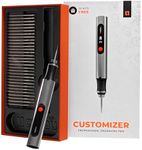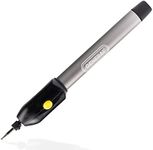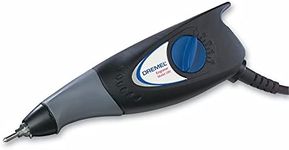Buying Guide for the Best Engraving Pens
Choosing the right engraving pen can make a big difference in the quality and ease of your engraving projects. Whether you want to personalize gifts, mark tools, or create art, it's important to understand the main features of engraving pens so you can select one that matches your needs and comfort level. By focusing on the key specifications, you can find a pen that feels good in your hand, works well with your chosen materials, and delivers the results you want.Power SourceThe power source of an engraving pen refers to how it is powered—either by batteries, electricity (plug-in), or manually. This is important because it affects portability, convenience, and the type of work you can do. Battery-powered pens are great for portability and small projects, while electric pens offer more consistent power for longer or tougher jobs. Manual pens require no power but need more effort and are best for light, occasional use. Think about where and how often you'll use the pen to decide which power source fits your lifestyle.
Tip Material and SizeThe tip of the engraving pen is the part that actually makes contact with the material, and its material and size determine what kinds of surfaces you can engrave and how detailed your work can be. Harder tips, like tungsten carbide or diamond, are better for tough materials like metal or glass, while softer tips work well on wood or plastic. Smaller tips allow for finer, more detailed work, while larger tips are better for broad, less detailed engraving. Choose a tip that matches the materials you plan to engrave and the level of detail you want in your projects.
Speed SettingsSpeed settings refer to how fast the tip moves or vibrates. This matters because different materials and engraving styles require different speeds. Pens with adjustable speed let you work on a wider range of materials and give you more control over the depth and appearance of your engraving. Lower speeds are good for soft materials and detailed work, while higher speeds are better for hard materials and faster engraving. If you want versatility, look for a pen with multiple speed options.
Ergonomics and WeightErgonomics and weight describe how comfortable the pen is to hold and use, especially for longer periods. A pen that is too heavy or awkward can cause hand fatigue and make it harder to control your engraving. Lightweight, well-balanced pens with comfortable grips are easier to handle and allow for more precise work. If you plan to use the pen for extended sessions or detailed designs, prioritize comfort and ease of use.
Noise and Vibration LevelNoise and vibration level refer to how much sound and movement the pen produces during use. High noise and vibration can be distracting or uncomfortable, especially if you are working indoors or for long periods. Some pens are designed to be quieter and smoother, which can make the engraving process more pleasant. If you are sensitive to noise or plan to use the pen in a shared space, consider models that are known for being quieter and having less vibration.
Material CompatibilityMaterial compatibility means the types of surfaces the engraving pen can work on, such as metal, glass, wood, plastic, or leather. Not all pens can engrave all materials, so it's important to check this before buying. If you have a specific project in mind, make sure the pen is suitable for that material. If you want to experiment with different surfaces, look for a pen that is versatile and can handle a variety of materials.










